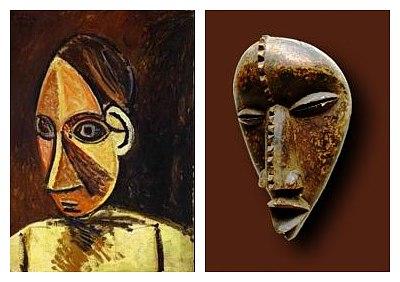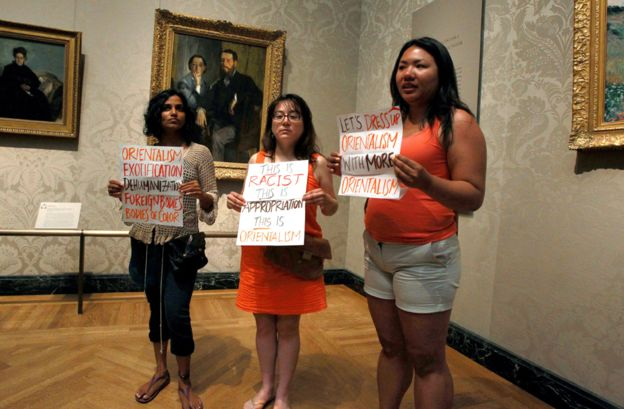
Globalization as a threat to cultural identity
"Art gives birth to the identity of a people. And the memory of a nation is built in museums". - Bertran Hauger
The possibility of a transnational artworld
In words of the philosopher Noël Carroll, transnational artworld must be understood as the artworks across the world that, even when they have their origins in different cultures, are starting to share the same language games and traditions, as result of the process of integration that the world is going through. This means that when it comes to international exhibitions in museums or galleries, for instance, we might find a common art culture between a museum located in France and one located in Japan.
But we must mention that as much as we may be in front of one Hindu goddess statue and Michelangelo’s David, the one that will get more recognition is the one that proceeds from the Western culture and this is the kind of art that we will find in international museums all over the world. Therefore, we can see that non-western art are not present in this proposed concept of transnational artworld, because they would have entered the story of art as an outside artwork or maybe just as an influence to the Western artworld.
African influence in Picasso's art work
Moreover, the idea of transnational artworld is present when we note that the artists seek to get a cosmopolitan appreciation of local art, trying to make these artworks valued and understood by viewers from different parts of the world. As Carroll says, “this may involve the juxtaposition of high and low, but in terms of globalization, the terms of the juxtaposition might be the local and the traditional, on the one hand, versus something of modernizing import, on the other” (Carroll, 2007, p. 141).
So this is the strategy which makes that transnational artworld actually works, it takes and connects the artistic practices in different localities worldwide and makes a transnational institution that breaks through every cultural context. And it makes sense, because the producers, the consumers, and the art itself share their own language and traditions, condensed in a global artworld, and we can see that there is a fusion between the cultural identities as a consequence of the multicultural constitution of the nation states nowadays and the emergence of transnational forms of popular culture.
National heritage and cultural identity
A key concept when we talk about nation states is the national heritage which in the eyes of Stuart is “the material embodiment of the spirit of the nation” (1999, p. 4). This concept is a construction or representation of the traditions, history, and culture of every nation through the collective social memory. So, we belong when we are able to identify ourselves with this idea and its special meaning.
Globalization has made it possible for the traditional elements of many cultures around the world to be known and even used or appropriated by Western culture. Thus, we can understand why cultural appropriation under the name of globalization causes such a controversy when it comes to asking who is entitled to represent the culture and traditions of others.
Therefore, the processes of globalization throughout history have been characterized by the predominance of Western culture and by the cultural imperialism. When talking about arts we would say that non-western art could be part of the history of art as an outside or as an external influence but not really as a main character. Consequently, the alternatives for non-western art and artist were to include an excessive nationalism in their works in order to counterbalance the western predomination or to follow the mainstream and include elements of both cultures in their works of art.
A European might collect Chinese porcelain or drawings, or, for that matter, later, pre-Colombian art, but these collectibles and the artists who created them did not enter the "big story" of art as it was told in the West (Carroll, 2007, p. 137).
People who participate of the protest against “cultural appropriation” during “Kimono Wednesday” in the Boston Museum of Fine Arts.
On the other hand, it is necessary to take into account that the cultural identity of a nation is also a historical and geographical process that is dynamic and it is constantly transforming. Nowadays, culture is constructed by individuals and different social groups who belong to the same national territory or to a similar ideological and cultural discourse. But also, culture is influenced by the constant interrelationships among other countries which have been accelerated by the phenomenon of globalization (Arias, 2009).
However, the representation or use of a foreign culture is an important matter that should not be taken lightly. Adding certain elements of other cultures must be the result of a continuous process of cultural exchange, there must be a background that gives us the authority or the right to use those elements in our own culture, otherwise, it would only be cultural appropriation.
Is the Louvre Abu Dhabi a bridge between cultures?
Since 2007, the governments of France and the United Arab Emirates announced the construction of a new museum on the Sadiyaat Island (" Island of Happiness"), which is part of a thirty-year agreement between those governments. They aim to create a new “universal” museum that will display artworks in which visitor can appreciate different civilizations developing in parallel.
The construction of this museum has brought many expectations and the Director General of the Abu Dhabi Tourism and Culture Authority, Mubarak Hamad Al Muhairi, shares this feeling, as he has mentioned that “Our universal museum will celebrate in advance intercultural dialogue so profoundly needed in the modern world and will be a place where people can connect with each other through the universal languages of arts”.
Nevertheless, the role of cultural identity in this matter has been of considerable importance to critics of this museum, because it claims to be a symbol of unity and universalism, it claims to have the unique position as the first universal museum to be constructed outside the Western world. Hence, some argue that the Louvre Abu Dhabi partnership was only about France’s presence in this region and its economic interest rather than bring cultural development or to create a new concept of an inclusive museum. Also, some others argue that this museum is an example of the westernization and that it represents a threat to Islamic values and local traditions, because bringing such an icon of western culture, as is the Louvre, will only show the colonial predominance still present in the contemporary era.
The museum alludes to a chronological framework focused on the ‘great cultures’, moving from stone tools, through Egyptian, Greek, and Roman culture, and then developing the European artwork, ending with modernist works. Therefore, what we really see in this so-called “universal” museum is a replica of the Louvre (or any other large-scale exhibition) simply located in Abu Dhabi, leaving aside the cultural wealth of the Arabian Peninsula, as the artistic works of this region are barely present in the exhibition. Once again, Western culture makes its way, opening our eyes to reality, that the Louvre Abu Dhabi is not something new, but a new victim of globalization.
Discussion Questions
1. Could transnational artworld include non-western art at some point?
2. Is it possible to preserve the cultural identity of a country in such a globalized world today?
3. Is globalization the only one to blame for cultural appropriation and the sense of losing sovereignty over traditions when they are represented by western culture?
Authors
María Paula Mojica
Valeria Estrada
References
Arias, L. (2009). La identidad nacional en tiempos de globalización. Dialnet. Last retrieved 07/10/2017
Carrol, N (2007) The Journal of Aesthetics and Art Criticism, Vol. 65, No. 1, Special Issue: GlobalTheories of the Arts and Aesthetics (Winter, 2007), pp. 131-143
Stuart, H. (1999). Un-settling 'the heritage', re-imagining the post. whose heritage? Third Text.
Exell, K (2016) Modernity and the Museum in the Arabian Peninsula

